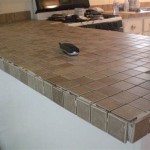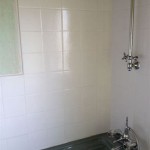Can You Put Vinyl Floor Tiles on Top of Ceramic? A Comprehensive Guide
When considering flooring renovations, a common question that arises is whether new materials can be installed directly over existing ones. Specifically, the possibility of installing vinyl floor tiles over ceramic tiles is frequently debated. This article aims to provide a comprehensive understanding of the factors involved in this process, outlining the potential benefits, drawbacks, essential preparation steps, and alternative solutions.
The appeal of installing vinyl flooring over ceramic is understandable. It offers a potential cost-effective and time-saving alternative to the more labor-intensive and expensive process of removing the existing ceramic tiles. Removing ceramic can be messy and disruptive, generating significant dust and requiring specialized tools. Installing vinyl directly on top appears to bypass these inconveniences. However, a successful installation requires careful consideration of several critical factors.
Understanding the Advantages and Disadvantages
Choosing to install vinyl over ceramic comes with both advantages and disadvantages. Weighing these carefully is crucial to making an informed decision that aligns with the specific needs of the project and the condition of the existing ceramic floor.
On the advantage side, the most significant benefit is the reduction in labor and time. Eliminating the removal process translates into faster project completion, lower labor costs (if hiring professional installers), and less disruption to the living space. Additionally, vinyl flooring is generally more comfortable underfoot than ceramic, offering a softer and warmer surface. It can also improve the acoustic properties of the room by reducing noise transmission.
From a structural perspective, adding a layer of vinyl on top of ceramic can increase the floor's overall thickness, which can be beneficial in some situations, such as leveling uneven subfloors or raising the floor height to match adjacent rooms. Furthermore, vinyl flooring is known for its water resistance, offering an added layer of protection against moisture damage, particularly in areas prone to spills or leaks.
However, the disadvantages are equally important to consider. The primary concern is the potential for problems arising from an uneven or unstable ceramic surface. Any imperfections in the ceramic, such as cracks, chips, or uneven grout lines, can telegraph through the vinyl over time, creating an unsightly and potentially unstable floor. This is particularly true for thinner vinyl products.
Another potential issue is trapped moisture. If moisture is present beneath the ceramic tiles, it can become trapped between the ceramic and the vinyl, leading to mold growth and adhesive failure. This is especially relevant in bathrooms, kitchens, or basements where moisture levels are typically higher. Furthermore, the added height can create transitions that are not aesthetically pleasing or potentially hazardous, especially if the height difference is substantial. It also needs to be confirmed that doors will still swing freely and appliances will still fit under counters.
Key Preparation Steps for Installing Vinyl Over Ceramic
If the decision is made to proceed with installing vinyl over ceramic, thorough preparation is absolutely essential for a successful outcome. Neglecting these steps significantly increases the risk of future problems and ultimately undermines the longevity of the new floor.
The first step is a meticulous inspection of the existing ceramic floor. Every tile should be checked for cracks, chips, looseness, or any other form of damage. Any loose or damaged tiles should be removed and the resulting gaps filled with a suitable patching compound. The patching compound should be allowed to dry and cure completely according to the manufacturer's instructions before proceeding.
Next, the ceramic surface must be thoroughly cleaned to remove any dirt, grease, wax, or other contaminants that could interfere with the adhesion of the vinyl. A strong degreasing cleaner is recommended, followed by a thorough rinsing and drying of the surface. This step is crucial for ensuring a strong and lasting bond between the vinyl adhesive and the ceramic.
Addressing uneven grout lines is another critical task. Grout lines can create noticeable indentations in the vinyl, detracting from the finished appearance. To mitigate this, a self-leveling underlayment is often recommended. This liquid compound is poured over the ceramic surface and allowed to flow into the grout lines, creating a smooth and level surface for the vinyl installation. It is essential to choose a self-leveling underlayment that is compatible with both ceramic and vinyl flooring and to follow the manufacturer's instructions carefully regarding mixing ratios, application thickness, and drying times.
Once the self-leveling underlayment is fully cured, it may be necessary to lightly sand the surface to remove any imperfections or ridges. This will further ensure a smooth and even surface for the vinyl installation. A primer designed for use with vinyl flooring may also be recommended to enhance adhesion, depending on the specific vinyl product being used.
Alternative Flooring Solutions and Considerations
While installing vinyl over ceramic might seem like a straightforward solution, it is important to consider alternative flooring options and their suitability for the specific circumstances. Sometimes, a different approach might offer a more durable, aesthetically pleasing, or cost-effective solution in the long run.
One alternative is to remove the existing ceramic tiles entirely. While this is a more labor-intensive process, it allows for a clean slate and eliminates the potential problems associated with an uneven or unstable ceramic base. Removing the ceramic also allows for inspection of the subfloor underneath, providing an opportunity to address any underlying issues such as moisture damage or structural problems.
Another option is to install a different type of flooring altogether. For example, laminate flooring, engineered hardwood, or even a thicker, more rigid type of vinyl plank flooring might be better suited for installation over ceramic, particularly if the ceramic surface is uneven or has significant grout lines. These types of flooring are often designed to be more forgiving of minor imperfections in the subfloor.
When considering alternative flooring solutions, it is essential to factor in the overall cost, including materials, labor, and any necessary preparation work. It is also important to consider the long-term durability and maintenance requirements of each option. While the initial cost of removing ceramic tiles might be higher, it could potentially save money in the long run by preventing future problems and ensuring a longer lifespan for the new flooring.
One should also consider the specific limitations and constraints of the space. Factors such as ceiling height, door clearances, and the presence of existing fixtures might influence the choice of flooring. For example, if adding a new layer of flooring would significantly reduce ceiling height or interfere with door operation, removing the existing ceramic might be the only viable solution.
In conclusion, while it is possible to install vinyl floor tiles over ceramic tiles, it is not always the best solution. Careful consideration of the advantages and disadvantages, thorough preparation, and evaluation of alternative flooring options are all essential for a successful and long-lasting result. Consulting with a professional flooring contractor is highly recommended to assess the specific conditions of the space and determine the most appropriate flooring solution.

Transform Your Home Installing Vinyl Flooring Over Ceramic Tiles City Wall And Floor

Installing Luxury Vinyl Over Existing Tiles Choices Flooring

How To Install Ceramic Tile Over Vinyl Flooring

What Type Of Flooring Can You Install Over Ceramic Tile

How To Install Vinyl Or Laminate Flooring Over Existing Ceramic Tile

What Type Of Flooring Can You Put Over Ceramic Tile

How To Install L Stick Tile Over Existing Bathroom Vinyl Floor Diy Power Couple

How To Install Vinyl Flooring Over Ceramic Tile Step By This Old House

Should You Tile Over Vinyl Flooring Builddirect

How To Lay Vinyl Flooring Sheet Over Tiles
Related Posts








